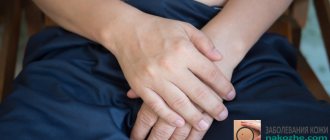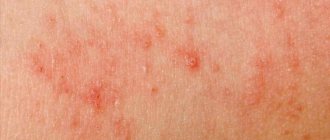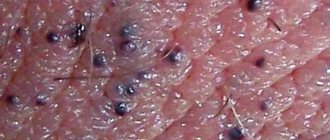A lump on the pubis in men and women can signal the progression of many pathologies. According to statistics, about 60% of patients admitted to the hospital with a similar symptom notice negative signs in the body at later stages of the development of the pathology.
Therefore, treatment of a lump in the groin proceeds in an intensive mode. However, it happens that a lump on the pubis in women and men is an ordinary boil or ingrown hair and does not require surgical treatment.
Causes of ingrown hairs and bumps in the bikini area
Why did ingrown hair in the bikini area become a bump? There is only one answer to this question – incorrect hair removal. If the vegetation is not removed by the roots during the procedure, but breaks off, this leads to the fact that its lower part remains in the depths of the epidermis.
When the hair tries to grow further, a lump is formed - a manifestation of pseudofolliculitis. Under the skin, the hair bends or twists and causes an inflammatory process.
The appearance of tubercles at the site of ingrown hairs is due to several reasons:
- Damage to the bulbs during hair removal.
- Shaving with a blunt machine against the “wool”.
- Clogged hair canals due to improper hair removal.
- Damage to hair during depilation at the upper level of the epidermis.
- Increased skin density in the bikini area, making hair removal difficult.
- Hereditary predisposition to ingrown hairs.
Also, hair can grow into the skin of the intimate area and turn into lumps due to endocrine or hormonal disruptions in the body, completely unrelated to the hair removal process, or when constantly wearing underwear made of synthetic fabric. Artificial material does not absorb sweat and secretions well and allows little air to pass through, which increases the risk of developing inflammation and pseudofolliculitis.
Symptoms
The ball on the skin in the groin can behave differently. Most often, patients note the following general symptoms when a lump appears:
- pain on palpation and walking. Discomfort may radiate to the stomach and pelvic area;
- enlargement of nearby lymph nodes;
- the appearance of excessive pigmentation (redness, bluish discoloration of the skin), development of itching, irritation;
- deterioration in general health (apathy, fatigue, loss of appetite, increased body temperature).
If the ball under the skin does not go away for a long time and provokes a deterioration in the patient’s general condition, it is necessary to consult a doctor for diagnostic tests.
Control measures
Bumps over ingrown hair in women can appear not only in the intimate area, but also in the lower part of the limbs. Men sometimes face problems after shaving their face and neck.
If an ingrown hair makes its way to the surface of the dermis, you can try to remove it with a thin needle:
- Sewing tools and skin are disinfected.
- The hair is pryed with the tip and pulled out.
- The operated area is treated with alcohol or hydrogen peroxide.
- For rapid tissue regeneration, wound healing ointment is used.
But what to do if the hair has grown too deep into the bikini area and a real red bump has already formed? First of all, you need to understand that redness indicates inflammation with possible accumulation of pus. You can try to correct the situation at this stage with the help of ointments, lotions, and soft scrubs.
If the tubercle becomes larger in size and hurts, it is better to consult a dermatologist. The doctor will open the papule with a sterile needle or scalpel, clean and rinse the wound, and cover it with a sterile bandage. Disinfect the treated area with Chlorhexidine or hydrogen peroxide. Bandages are changed daily.
Causes of compaction formation
A seal on the pubis in men and women signals the development of many pathologies in the body: these can be diseases of the musculoskeletal system, skin and lymphatic diseases. The cause of the development of a lump above or below the pubis can be determined after a comprehensive diagnosis.
The situation may become a little clearer if you familiarize yourself with the general picture of the pathologies that led to the appearance of the swelling. A lump in the pubic area: what is it, what pathologies can be caused - below are the main reasons for the appearance of lumps.
Hernia
If the ball is red and hurts when pressing and walking, this may indicate the development of an inguinal hernia. Men are more susceptible to the disease. Most often, the pathology occurs against the background of frequent overeating and muscle tension.
The subcutaneous neoplasm is initially small in size (from 0.5 to 2 cm). As the hernia progresses, the tumor can grow up to 5 cm. The hernia tumor has a soft consistency, and the pain may intensify upon palpation. It is not possible to eliminate the tumor on your own. If it grows, surgical intervention will be required.
Lipoma
If the ball in the groin does not hurt, this indicates the development of a benign neoplasm - lipoma. Women are more susceptible to the development of pathology (including during pregnancy). A benign ball in the groin area does not harm the patient’s health and does not develop into an oncological tumor. Most often, it measures up to 2-3 cm. Causes of lipoma:
- unhealthy lifestyle: abuse of nicotine products, frequent alcohol consumption, unbalanced diet;
- high blood cholesterol levels;
- hormonal disbalance;
- genetic predisposition.
A small subcutaneous ball, although it does not cause pronounced symptoms, still requires timely treatment. In the early stages, you can get rid of the tumor using topical products. In advanced cases, surgical removal of the lipoma will be required.
Cyst
A ball in the groin in women and men can be a sebaceous cyst. The pathology is formed when the duct of the sebaceous gland is blocked.
A ball-shaped seal in this case appears for the following reasons:
- failure to comply with hygiene standards;
- excessive sweating;
- excess weight and endocrine disorders;
- hormonal disbalance;
- injury to the problem area;
- improper hair removal in women.
The ball under the skin in the groin has a hard consistency. It is easily palpable and begins to cause discomfort upon palpation. Over time, the tumor tends to grow and fester.
A neoplasm with pus inside is dangerous to human health, since if the internal capsule bursts and its contents enter the bloodstream, it can become infected. The cyst is removed surgically. In some cases, it resolves on its own. Photos of the cyst can be seen on online medical portals.
Ingrown hair
If the seal between your legs in the groin hurts when you touch it, this also indicates the appearance of an ingrown hair. Most often, girls encounter this pathology due to improper hair removal of the intimate area.
The ball under the skin usually reaches 1-2 cm in size, causes discomfort when walking, becomes covered in a rash and itches. As the inflammatory process progresses, groups of small balls may form on the skin, causing severe discomfort. Tumor-like formations can be removed using specialized ointments (at an early stage) or surgery (in more advanced cases).
Furuncle
If a hard ball appears to the right or left of the pubis, which itches and causes discomfort, this indicates the appearance of a boil. These are dense neoplasms that form when infections and bacteria enter the body. Also, a boil can develop against the background of the following pathologies:
- diseases of the endocrine system;
- liver and kidney pathologies;
- allergic reactions.
Also, a neoplasm can appear due to excessive sweating and blockage of the sebaceous glands. Pathology is treated with external agents. After recovery, relapses are possible.
Inflamed lymph node
If a ball with clear boundaries has formed between the legs of a child or an adult, which is easily palpable upon palpation, this indicates inflammation of the lymph nodes. In this case, the neoplasms are painful when touched. Additional symptoms include redness, itching, and burning.
Lymph nodes become inflamed for the following reasons:
- STDs (gonorrhea, syphilis);
- gynecological diseases;
- HIV;
- pathologies of the lymphatic system;
- prostate diseases;
- oncological neoplasms.
It is forbidden to touch inflamed lymph nodes with your hands, try to squeeze them out or comb them. Treatment in this case is carried out both locally and surgically.
Varicose veins of the superficial femoral veins
Predominantly a female disease. Most often, varicose veins develop against the background of prolonged physical exertion and prolonged exposure to a static position.
It is not uncommon for pathology to occur in women during pregnancy. As varicose veins progress, the patient develops a dense lump on the skin that can be easily felt with the fingers. The tumors hurt, pulsate, and cause discomfort when walking.
Neurofibroma
A benign neoplasm that develops in the groin area in the layers of connective tissue. Neurofibroma rarely develops into a malignant tumor.
In the initial stages, the pathology is not accompanied by negative symptoms. However, the disease should not be ignored in any case. As neurofibroma progresses, the ball under the skin tends to grow deep into the periosteal tissue and form painful growths.
Hygroma
A harmless growth under the skin, which is a type of cyst. The tumor appears as a result of the accumulation of secretions between the tendons when they are constantly in a state of tension. Most often, hygroma forms on the wrists, but there are cases of its appearance in the groin area.
Other reasons
A ball in the groin in men and women often appears with the development of the following pathologies in the human body:
- female gynecological diseases (thrush, erosion, andexitis);
- viral infections that affect the entire human body (flu, herpes, rubella);
- diseases of the urinary system;
- dermatological skin diseases.
A lump in the groin area may be a symptom of a fungal infection.
Self-removal of lumps
Home removal of bumps in the bikini area may seem complicated to some, but a very simple operation to others. If a girl does not want to go to the hospital, she can get rid of the ingrown hair on her own and heal the damaged skin.
How to properly remove a lump on your own:
- For two days, lubricate the affected area of skin with external products Proderm, Baziron, Dalatsin. Ointments will relieve swelling and redness.
- Use a scrub to remove dead particles from the dermal layer.
- Rinse the skin and give it a rest from various aggressive actions for several days.
A scrub for treating bumps over an ingrown hair is prepared from ground coffee, sugar and vegetable oil. The composition is alternated with a scrub made from turmeric, olive oil and salt, or with store-bought products.
To soften the bumps in the bikini area, on the legs and in the armpits, preparations containing salicylic acid and benzoyl peroxide are applied to protruding points 2-3 times a day. Ointments and creams with this composition relieve inflammation and accelerate regeneration processes.
Warm compresses are applied to the problem area to make it easier for the stuck hair to come to the surface. Make a compress as follows:
- The towel is soaked in hot water and applied to the bikini area.
- The procedure is repeated several times, soaking a cooled towel in boiling water.
Ready-made products for ingrown hairs and special impregnated wipes are sold in a pharmacy or cosmetic store. But they are expensive, and they are not always 100% effective.
Diagnosis and treatment
A specialist may prescribe the following diagnostic tests to establish a diagnosis:
- general blood and urine analysis;
- hormonal study;
- autoimmune research;
- scraping (if skin pathologies are suspected);
- tests for STDs;
- Ultrasound of the groin area;
- MRI;
- puncture (if cancer is suspected).
Treatment tactics depend on the diagnosis:
- pathologies resulting from blockage of the sebaceous glands are treated with ointments and creams for external use; in advanced cases, the tumor is excised by a surgeon;
- cystic formations in most cases are removed surgically;
- viral pathologies are treated with antibiotics, antiviral and immunostimulating agents;
- STDs are eliminated with antibiotics, antifungals and anti-inflammatory drugs.
How to prevent bumps from forming
Pseudofolliculitis, despite the prefix “pseudo,” is an undesirable condition for the body. The skin with such a problem looks inflamed and suppurated. Some people ignore the symptoms of pseudofolliculitis and do not treat it in any way. And in vain, because in most cases, bulges can not only be removed, but also their formation can be prevented.
How to prevent the formation of bumps due to ingrown hairs:
- Exfoliate regularly and do not forget about it before epilation. The result of the procedure is the elimination of dead cells.
- Use razors with clean, sharp blades. People who often face the problem of ingrown hairs should shave no more than 2 times in 7 days to prevent bumps.
- Wipe the skin thoroughly with an antiseptic before and after hair removal. Disinfection protects follicles from infection by microbes and inflammation.
- Wear soft cotton underwear that does not damage the delicate bikini area.
- Wax and sugar hair removal should only be done in a salon by an experienced professional. Avoid repeating the procedure soon if ingrown hairs appear.
To ensure that bumps never form in the bikini area, it is necessary to remove hair there as little as possible. As they grow, they become stronger and more susceptible to depilation.
What not to do if a lump forms
Having noticed bumps after epilation of the bikini area, many women try to remove them themselves using improvised means. After reading reviews on how to get rid of ingrown hairs and lumps in the intimate area at home, a person can both help himself and aggravate the problem.
You should not pick at the bulge or remove ingrown hair on your own without medical advice. Any wrong action by the average person is fraught with the spread of the inflammatory process into the deep layers of the epidermal structure, and then the surgeon will cut out the tubercle.
Mistakes that women and men often make when developing post-epilation inflammation:
- Treat the skin surrounding the ingrown hair with depilatory cream.
- Squeezing the papules with your hands in an attempt to extract the purulent contents.
- Neglecting the problem and using a hair removal method that constantly leads to ingrown hairs.
- Removing hair under bumps using non-sterile equipment.
- Reluctance to waste time treating the surface to be depilated with antiseptics.
All this leads to a gradual increase in the number of tubercles and increased development of the inflammatory process. At the first signs of pseudofolliculitis in the bikini area, doctors recommend immediately contacting the clinic. Otherwise, the reddened bulge will cause pustular skin lesions and sepsis - blood poisoning.
How to remove an ingrown hair bump
Folliculitis – that’s what the problem of ingrown hairs is called – can be treated independently and at home. The essence of this method will be the use of herbal medicine.
The surface of the skin should be treated with various antiseptic herbal decoctions. Chamomile, plantain, calendula, elecampane, and St. John's wort have proven their effectiveness more than once.
These products cleanse the skin well of bacteria and dry it out. To nourish the body with beneficial substances from the inside, you should drink an infusion of oak bark, chamomile or burdock root. The greatest effect can be achieved if you use plants in combination.
The surface of the skin should be treated with various antiseptic herbal decoctions. Chamomile, plantain, calendula, elecampane, and St. John's wort have proven their effectiveness more than once.










